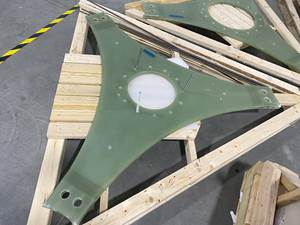Reshoring, right shoring and innovation: Implications for composites
A CT columnist, consultant and president of Dayton, Ohio-based Quickstep Composites, the U.S. subsidiary of Australia-based Quickstep Technologies (Bankstown Airport, New South Wales), Dale Brosius sees a recent trend toward reshoring, as U.S. manufacturers retrench after decades of outsourcing fabrication to low-wage locales in emerging economies.
In May, the U.S. Bureau of Labor Statistics reported that the U.S. economy had recovered all the jobs lost during the global financial crisis and the “Great Recession” that followed, matching the peak employment of January 2008. Although this was encouraging news, there are certainly structural elements that have kept wages stagnant and growth rates restrained, so more progress needs to be made. Economies in Europe are still recovering, and the shifting global landscape continues to impact decisions about where things are made and the technologies used to make them. Throw in the increasing emphasis on reducing carbon emissions and the future gets even more complicated. All of these factors have implications for composites. Some thoughts:
The offshoring trend may now be in reverse. In the late 1990s and through most of the 2000s, large global companies rushed into China and other countries with low labor costs, seeking to produce existing product designs for less, and thereby maintain or grow margins. Called “offshoring,” this transfer of production from Europe and North America to Asia led to large drops in manufacturing employment and the closure of many tool-and-die shops and numerous small molders, particularly injection molders. Today, wages are increasing at the rate of 15 percent per year in China, and we see rising logistical costs and more competitive prices for natural gas and plastics in the U.S. and in Europe. The savings previously gained through offshoring has eroded considerably. Molders I have talked to clearly note that they feel less competitive pressure from Asian suppliers. Anecdotal evidence indicates that a number of companies are “reshoring,” that is, bringing work back to the U.S. and Europe.
Manufacturing for local markets makes sense again. Although exports always have been a basis for a country’s competitive advantage in the world, the rise in living standards in formerly low-wage countries has created local demand for products ranging from mobile phones and other electronics to durable goods, such as appliances and automobiles. China’s wage hikes have created buying power: China produced more than 22 million motor vehicles in 2013, virtually all of them for domestic consumption. According to statistics published by the Organisation Internationale des Constructeurs d’Automobiles (OICA, Paris, France), that number is almost twice as much as U.S. production and ten times the number China produced in 2000. As reinforced plastics grow in importance for automobile fabrication, this represents great opportunities for composites. And data provided by the Global Wind Energy Council (GWEC, Brussels, Belgium) indicates that Asia, led by China, is far and away the world’s largest market for new wind turbine installations, generating significant sales of composite materials. Further, increased automation in manufacturing has reduced the impact of labor in countries where wages are high, and the desire to customize products for local markets is driving companies to invest in factory capacity close to the markets they serve, all over the globe. I have seen the term “right shoring” appropriately used to define this trend.
Innovation is driving growth in composites and doing so on a global basis. The pressure to reduce greenhouse gas emissions is rising in Europe, Japan and the U.S., pushing OEMs to find ways to reduce energy consumption in the manufacturing and use of products. This has pushed development of lighter, more fuel-efficient automobiles and aircraft, creating opportunities for composites. The latest aircraft from Boeing, Airbus and Bombardier are much more fuel-efficient than their predecessors and incorporate significant percentages of advanced composites. Increased use of hybrids and all-electric powertrains in ground vehicles is creating a demand for aluminum and composite structures to offset the weight of battery packs and, thus, improve driving range. Composites manufacturing processes are rapidly advancing to meet the higher rates required for true mass production. Although Germany currently leads in this area, significant investments in R&D are planned elsewhere in the world (including China) to make high-volume composites production a global reality. Development of larger wind turbines and more efficient solar panels will rely on composite materials reinforced with carbon fiber and on nanocomposites to push the proportion of energy generated by renewables to much higher levels than exist today.
All of these trends promise greater use of composite materials. The biggest challenges may be educating a sufficient number of engineers, designers and manufacturing workers who will make these opportunities into realities, and then ensuring that they have access to an adequate supply of materials in high-demand markets. I believe we will rise to meet this challenge, just as we are doing to improve material performance and raise manufacturing rates, ushering in sustainable growth for the next several decades.
Related Content
RTM, dry braided fabric enable faster, cost-effective manufacture for hydrokinetic turbine components
Switching from prepreg to RTM led to significant time and cost savings for the manufacture of fiberglass struts and complex carbon fiber composite foils that power ORPC’s RivGen systems.
Read MoreMingYang reveals 18-MW offshore wind turbine model with 140-meter-long blades
The Chinese wind turbine manufacturer surpasses its 16-MW platform, optimizes wind farm construction costs for 1-GW wind farms.
Read MoreComposites end markets: Batteries and fuel cells (2024)
As the number of battery and fuel cell electric vehicles (EVs) grows, so do the opportunities for composites in battery enclosures and components for fuel cells.
Read MoreAchieving composites innovation through collaboration
Stephen Heinz, vice president of R&I for Syensqo delivered an inspirational keynote at SAMPE 2024, highlighting the significant role of composite materials in emerging technologies and encouraging broader collaboration within the manufacturing community.
Read MoreRead Next
VIDEO: High-volume processing for fiberglass components
Cannon Ergos, a company specializing in high-ton presses and equipment for composites fabrication and plastics processing, displayed automotive and industrial components at CAMX 2024.
Read MoreAll-recycled, needle-punched nonwoven CFRP slashes carbon footprint of Formula 2 seat
Dallara and Tenowo collaborate to produce a race-ready Formula 2 seat using recycled carbon fiber, reducing CO2 emissions by 97.5% compared to virgin materials.
Read More“Structured air” TPS safeguards composite structures
Powered by an 85% air/15% pure polyimide aerogel, Blueshift’s novel material system protects structures during transient thermal events from -200°C to beyond 2400°C for rockets, battery boxes and more.
Read More





















